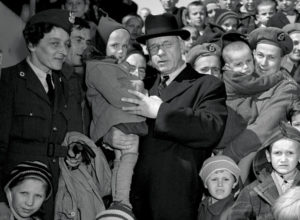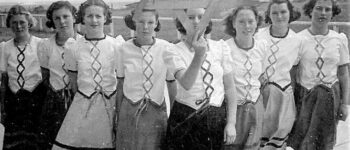1939: Polish Diaspora
September 29, 2021
By AHNZ
 This photo from Granity District High School in 1939 is a good image to go with the Polish Diaspora. It shows eight girls in European-like traditional costume and a large Star of David. The background seems to show the coast, as befitting the West Coast school the caption claims these students as attending.
This photo from Granity District High School in 1939 is a good image to go with the Polish Diaspora. It shows eight girls in European-like traditional costume and a large Star of David. The background seems to show the coast, as befitting the West Coast school the caption claims these students as attending.
[Note: The photo is of affiliates of the New Zealand Society for English Folk Dancing. See note at post foot]
Poland was in crisis during 1939, especially the Jewish population. Hitler’s Germany invaded Poland on 1 September of that year which, finally, put an end to Britain’s policy of appeasement. New Zealand’s Labour 1.0 Government followed the lead of Britain in declaring war on Germany in the last minutes of 3 September 1939.
 Acting Prime Minister Peter Fraser was doing the talking but on September 5th PM Michael Savage was broadcast saying the famous lines about Britain from his bed, “Where she goes, we go; where she stands, we stand.” Savage had about 6 more months to live.
Acting Prime Minister Peter Fraser was doing the talking but on September 5th PM Michael Savage was broadcast saying the famous lines about Britain from his bed, “Where she goes, we go; where she stands, we stand.” Savage had about 6 more months to live.
By this time Polish Jews with the better reflexes had already made an exit from their home in a world-wide diaspora. A few hundred made it to New Zealand. Perhaps some came to the West Coast joining earlier Polish migrants. The above image, being 1939, seems to show an affinity with the plight of Poland and perhaps members of the Polish Jew community. However, a source on the West Coast History page on Facebook says one of the girls is her mother and the girls were acting in a play1.
“This morning, the British Ambassador in Berlin handed the German Government a final note stating that unless the British Government heard from them by 11 o’clock that they were prepared at once to withdraw their troops from Poland, a state of war would exist between us. I have to tell you now that no such assurance has been received, and that consequently this country is at war with Germany.”- Prime Minister Neville Chamberlain, 3 September 1939
“The inter-war periodThe next migrants from Poland were Polish Jews who arrived in the inter-war period as refugees from European anti-Semitism. They numbered at most a few hundred. Their Jewishness did not prevent them also identifying themselves as Polish, and they formed an association of Polish Jews in Wellington in 1944. This organisation later helped non-Jewish Polish migrants who arrived during and after the Second World War.” – Poles, Te Ara; Wayback Machine
“Thank you for your phone call and email re girls in European costume holding a Star of David at Granity High School opening (1939). This is an intriguing image. I have not seen this type of folk costume before. It contains elements that certainly appear to represent some regional Polish costumes in a very simplified form, such as a laced bodice and horizontally striped skirt. They may also represent Hungarian, Bohemia Moravia Sudetenland Czech or Bavarian costumes as well, in a simplified form.”
“My previous research showed that very few Jews were allowed into New Zealand in the lead up to World War 2. (This image was taken in late October 1939; Poland was invaded by Germany 1 September 1939 and unofficially by USSR on 17 September 1939). Those Jews who were admitted by immigration to NZ had to pay a poll tax and be sponsored for life by a local Jewish synagogue, so it is unlikely they are new arrivals to Granity / Westport.” – Lynette
“Today in New Zealand history, 31 October 1944, a boatload of Polish refugees (mainly children) arrived at Wellington. The rescue kids had been displaced by the Soviets after the conquest of Germany and were likely due for a life in the Gulag Archipelago.” – 1944: Little Poland, AHNZ
3 thoughts on "1939: Polish Diaspora"
Leave a Reply
 Like Comment Share
Like Comment Share






You saw Archives NZ newsreel?
Could you be less specific?